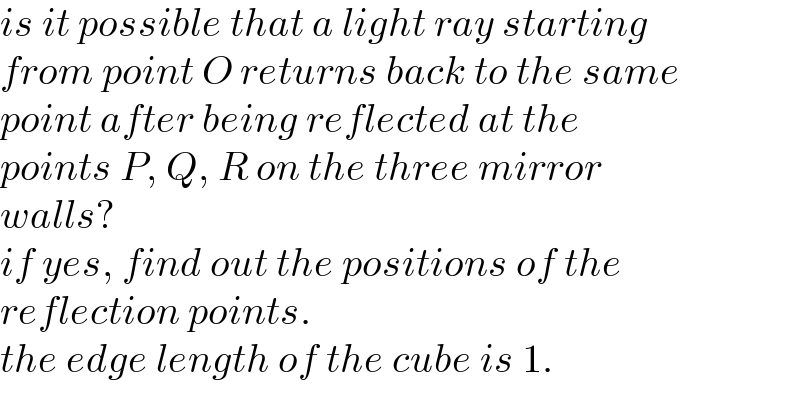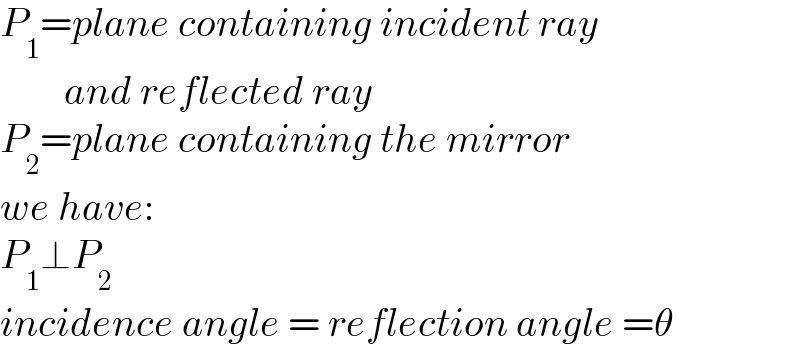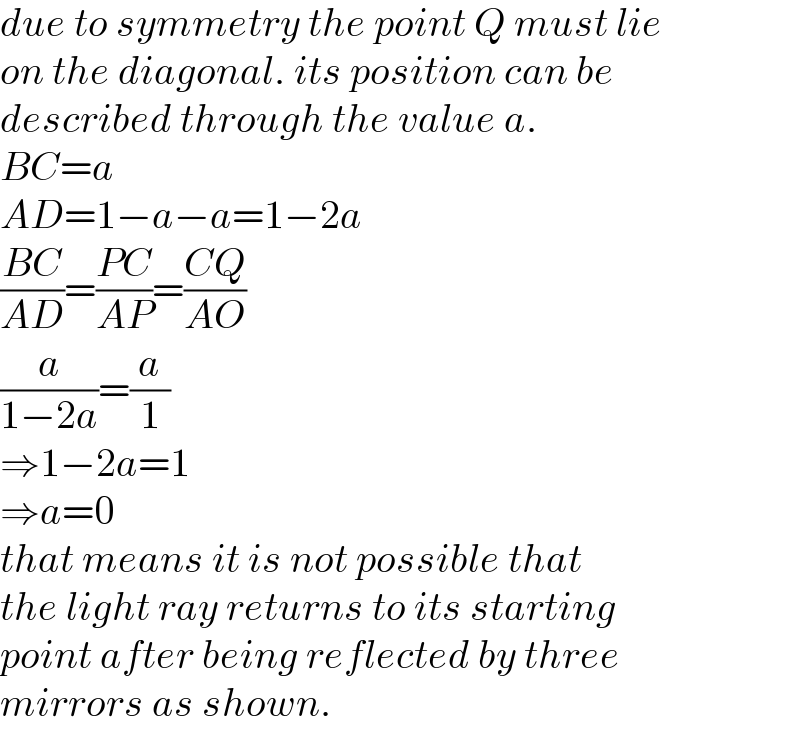Question Number 176966 by mr W last updated on 28/Sep/22

Commented by mr W last updated on 29/Sep/22

$${is}\:{it}\:{possible}\:{that}\:{a}\:{light}\:{ray}\:{starting} \\ $$$${from}\:{point}\:{O}\:{returns}\:{back}\:{to}\:{the}\:{same} \\ $$$${point}\:{after}\:{being}\:{reflected}\:{at}\:{the} \\ $$$${points}\:{P},\:{Q},\:{R}\:{on}\:{the}\:{three}\:{mirror} \\ $$$${walls}? \\ $$$${if}\:{yes},\:{find}\:{out}\:{the}\:{positions}\:{of}\:{the} \\ $$$${reflection}\:{points}. \\ $$$${the}\:{edge}\:{length}\:{of}\:{the}\:{cube}\:{is}\:\mathrm{1}. \\ $$
Answered by mr W last updated on 29/Sep/22

Commented by mr W last updated on 29/Sep/22

$${P}_{\mathrm{1}} ={plane}\:{containing}\:{incident}\:{ray} \\ $$$$\:\:\:\:\:\:\:\:{and}\:{reflected}\:{ray} \\ $$$${P}_{\mathrm{2}} ={plane}\:{containing}\:{the}\:{mirror} \\ $$$${we}\:{have}: \\ $$$${P}_{\mathrm{1}} \bot{P}_{\mathrm{2}} \\ $$$${incidence}\:{angle}\:=\:{reflection}\:{angle}\:=\theta \\ $$
Commented by mr W last updated on 29/Sep/22

Commented by mr W last updated on 29/Sep/22

$${due}\:{to}\:{symmetry}\:{the}\:{point}\:{Q}\:{must}\:{lie} \\ $$$${on}\:{the}\:{diagonal}.\:{its}\:{position}\:{can}\:{be} \\ $$$${described}\:{through}\:{the}\:{value}\:{a}. \\ $$$${BC}={a} \\ $$$${AD}=\mathrm{1}−{a}−{a}=\mathrm{1}−\mathrm{2}{a} \\ $$$$\frac{{BC}}{{AD}}=\frac{{PC}}{{AP}}=\frac{{CQ}}{{AO}} \\ $$$$\frac{{a}}{\mathrm{1}−\mathrm{2}{a}}=\frac{{a}}{\mathrm{1}} \\ $$$$\Rightarrow\mathrm{1}−\mathrm{2}{a}=\mathrm{1} \\ $$$$\Rightarrow{a}=\mathrm{0} \\ $$$${that}\:{means}\:{it}\:{is}\:{not}\:{possible}\:{that} \\ $$$${the}\:{light}\:{ray}\:{returns}\:{to}\:{its}\:{starting} \\ $$$${point}\:{after}\:{being}\:{reflected}\:{by}\:{three} \\ $$$${mirrors}\:{as}\:{shown}. \\ $$
Commented by Tawa11 last updated on 02/Oct/22

$$\mathrm{Great}\:\mathrm{sir} \\ $$
